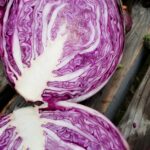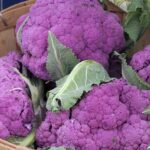If you’re enticed by color, consider planting purple vegetables this season. Beautiful in the garden, purple vegetables can actually provide extra health benefits. Seed companies offer a number of delightful possibilities.
“Purple carrots, potatoes and cauliflower have been shown to have higher antioxidant levels than less deeply pigmented varieties,” says Leslie Shallcross, a registered dietitian and Health, Home and Family Development agent for the UAF Cooperative Extension Service’s Tanana District office.
“They contain pigments called anthocyanins that add beneficial antioxidants to the diet,” she said. “While it is too early to make many health claims, anthocyanins are associated with reduced obesity and inflammatory responses.”
I remember well my first run-in with water-soluble anthocyanins. I was aghast to find my perfectly purple beans had turned to ordinary green upon cooking. Why grow purple vegetables if they are only to turn green? Reduced cooking time or steaming instead of boiling helps to minimize color loss. But not all purple vegetables fade upon cooking. Not all purple vegetables derive their color from anthocyanins and most vegetables contain many compounds beneficial to human health.
Vegetables contain many other types of beneficial phytonutrients. Tomato varieties and other vegetables are now being bred to contain greater nutrient amounts. This includes Indigo Rose, a tomato developed by Oregon State University that derives the purple color of its skin from anthocyanins, unlike purple and black heirloom tomatoes.
It’s difficult to talk about how nutritious one vegetable variety is compared to another. Some studies show purple carrots have twice the amount of carotenes as orange carrots, with trace amount present in yellow carrots varieties and no carotenes in white. So we should only eat purple carrots, right? No, this comparison is only true for the carrot varieties tested and it cannot be said that white vegetables are not nutritious. White cauliflower packs a lot of nutrients, although not the anthocyanins found in purple varieties. To complicate matters further, plant culture, storage and processing all affect a plant’s nutritional components.
Please note that eggplant, the quintessential purple vegetable, is best grown in a greenhouse. As a gardener without a greenhouse, I once grew the container variety Little Prince as a houseplant. I was impressed. The compact plant produced fruit in an east-facing window without supplemental light but I first had to figure out pollination. Jiggling the flowers didn’t work. I had to buzz like a bee and vibrate each blossom before it would set fruit.
Even though you’re excited about the purple vegetables you’ve toiled to grow, others may not be enthusiastic about eating purple food. When it comes to vibrant purple, All Blue potatoes pack a powerful purple punch. Boiled, mashed or fried, the color does little fading. Magic Molly is likewise purple, purple. It has five times more antioxidants than the traditional Russet Burbank, but can you convince your family to eat them? Tone down purple mashed potatoes by swirling a little of the purple in with white.
Introduce purple cauliflower by including a small portion of purple florets with the more familiar white. Select purple carrots with an orange center such as Purple Dragon rather than Purple Sun and other varieties that are completely dark purple.
The intense color of purple cauliflower is the result of tradition plant breeding, not genetic engineering. A single purple head was found in a field of white cauliflower and from that natural mutation, today’s purple varieties were developed. I’ve grown Violet Queen and Graffiti successfully but have not gotten Violetta Italia to produce heads.
Why not grow vegetables that provide extra benefits for health? Have some fun and “go to the dark side.” You’ll find 15 purple vegetables listed on Extension’s “Recommended Variety List for the Interior Alaska” at bit.ly/2U6Ptn9. To find out which vegetables should be started indoors, see Extension’s publication, “Seed Starting and Transplanting.” You can see that at bit.ly/2Aqe4fc.
Julie Riley is horticulture agent for UAF Cooperative Extension Service in the Fairbanks Tanana District office.

